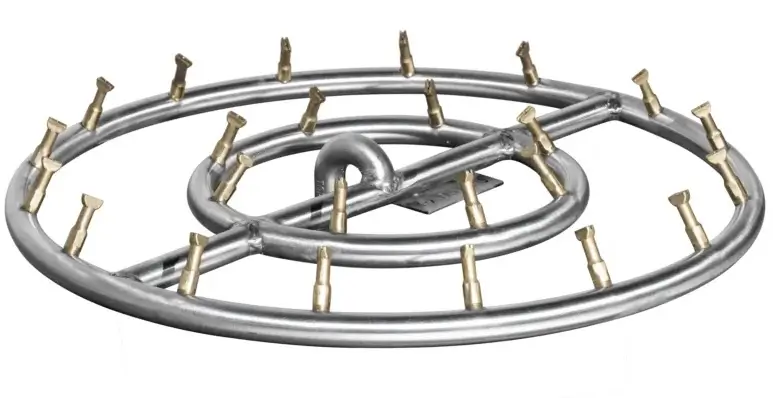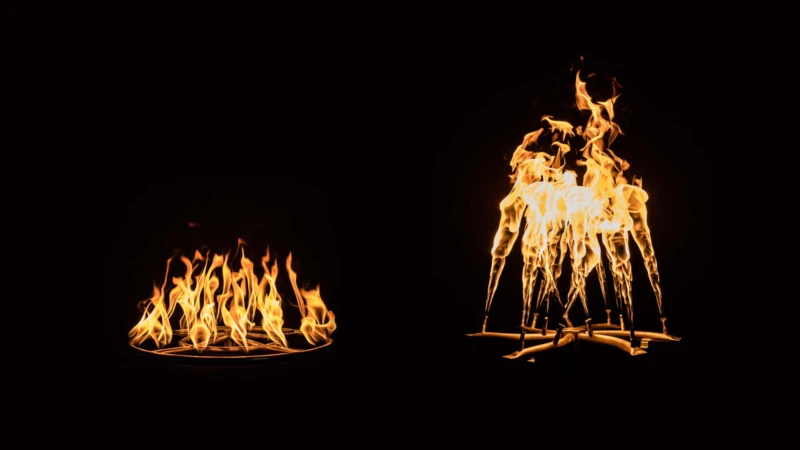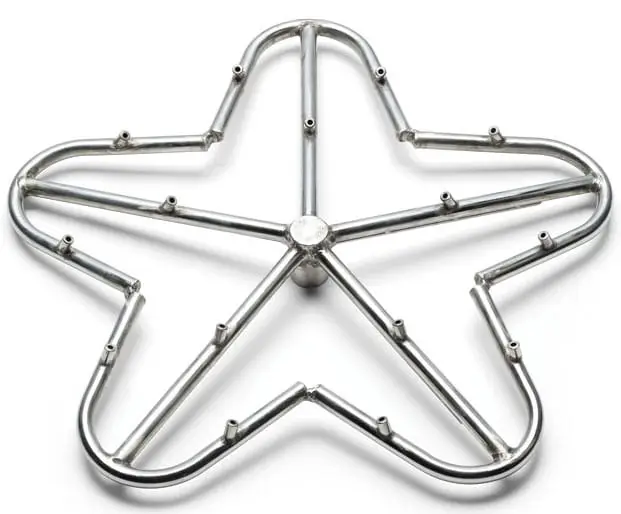As an authorized dealer for HPC Fire and The Outdoor Plus (TOP), we supply both Torpedo Burners and Bullet Burners. Both lines use patented nozzle jet technology to create a taller, more dramatic flame than a traditional ring burner. Many customers ask the same question: Which is better for my fire pit project?
This guide explains the engineering differences, cost factors, and specific applications for each to help you choose the right high-performance “engine” for your outdoor space.
Quick Comparison Summary
For readers who need the essential facts fast, here is a summary of the key differences:
| Feature | TOP Bullet Burner | HPC Torpedo Burner |
| Primary Flame Height | approx. 18 inches | approx. 22 inches |
| Air Mixer Valve | built into nozzle top | Required at base of burner |
| Nozzle Visibility | visible just above the media | Less visible flush with media |
| Material Options | Stainless/Brass or All-Brass | 304 Stainless Steel Only |
| 18-inch (Round) Price | $406 | $196.81 |
1. Flame Height and Engineering

A stainless steel and brass Bullet burner
Traditional ring burners release gas through small, drilled holes, producing an even, gentle flame. Both Torpedo and Bullet burners use precision nozzles to accelerate gas and mix it with air before ignition, resulting in a higher velocity and fuller flame.
Based on discussions I have had with the respective manufacturers Technical Depts., and subject to correct installation and gas supply, the key difference in output is height:
• HPC Torpedo Burner: Expected flame height is about 22 inches.
• Outdoor Plus Bullet Burner: Expected flame height is about 18 inches.
Note: These are guidance figures. Real-world results always depend on the gas supply pressure, ventilation, altitude, and media depth.

A great example of a traditional burner flame ( left ) and a nozzle burner flame ( right)
2. Air Mixing: The Key Technical Difference
This section covers the most important installation and aesthetic distinction between the two products: how each burner mixes air and gas.
Bullet Burners, The Outdoor Plus
The patented design involves a small flat section with tiny holes located near the tip of each brass nozzle.
- Gas exiting the tip naturally draws air in through these holes, creating the air-gas mix right at the nozzle.
- No separate air mixer valve is required for either natural gas or propane installations.
- Design Note: The fire media (glass or lava rock) must be set just below these intake holes to keep them clear. This makes the Bullet Burner’s brass nozzles more visible in the finished fire pit.
HPC Fire Torpedo Burners
HPC Fire’s design uses an entirely different approach.
- Air mixing is handled by a separate Air Mixer Valve installed at the base of the burner, below the fire pit pan or plate. This valve must be purchased and installed as part of the system.
- Because the air mixer valve is located at the base of the burner, mixing is external. Therefore the nozzles on the burner ring can sit nearly flush with the fire media, as long as the outlets are not blocked.
- Design Note: This results in a cleaner, more discreet look where only small stainless steel tips are visible.
3. Material Construction and Durability
Both manufacturers provide robust, high-quality products built to withstand the elements, with both lines protected by a Lifetime Burner Warranty.
| Burner | Material Options | Key Durability Notes |
| HPC Torpedo Burners | 304 Stainless Steel throughout. | Highly resistant to corrosion, ideal for coastal or high-moisture environments with minimal maintenance. |
| TOP Bullet Burners | Stainless and Brass Hybrid (Stainless gas ring with brass nozzles) or All Brass (Premium option). | Brass develops a natural patina over time. All-brass units may require more frequent cleaning and maintenance in saltwater or humid conditions. |
4. Flame Shape, Color, and Efficiency Clarified
Flame Shape
Aside from the height difference, the patterns are very similar, both offering a fuller, more voluminous flame compared to traditional burners.
- Circular layouts: Nozzles aim slightly inward to form a vertical cone.
- Linear layouts: Nozzles angle slightly off-center to create a ‘wider’ wall of flame.

A Stainless steel Torpedo Penta Burner
Efficiency Claim
You may have heard early marketing claims that these nozzles produce “twice the flame with half the gas.” This caused confusion.
- The Reality: Every burner has a BTU rating. A 150,000 BTU burner must receive 150,000 BTU to perform correctly, be it a nozzle or a traditional style burner. A nozzle-style burner will not fix a starved gas supply.
- The Intended Meaning: A smaller nozzle-style burner can match the visual flame size of a much larger, traditional ring burner while using a lower total BTU input. In this sense, they are more efficient at producing a dramatic flame size relative to BTU consumption.
5. Pricing Comparison (Typical Round Sizes)
Prices vary by size, material, and design. The figures below are typical burner-only prices without fittings, pans, or ignition kits.
| Size | HPC Torpedo Penta, 304 SS | TOP Bullet Stainless/Brass |
| 12 inch | $153 | $216 |
| 18 inch | $198.61 | $406 |
| 48 inch | $424 | $1,594 |
The significant price differences reflect the materials used, the complexity of the nozzle layout, the overall weight, and the unique air-mixing design of each burner.
6. Availability and Custom Options
Both lines are sold as individual components for retrofit and as complete fire pit systems. You can order match-lit, push-button spark, or electronic ignition kits. Electronic ignition adds the most cost and may require power and weather-rated enclosures.
Both HPC Fire and The Outdoor Plus excel at custom work. If you are planning a unique shape and want strong flame performance, contact us with your shape, cutout size, fuel, BTU target, ignition type, and media depth. We will prepare a quote for a custom Torpedo Burner or custom Bullet Burner.
Final Verdict: Which High-Performance Burner Should You Buy?
Both the HPC Torpedo Burner and the TOP Bullet Burner are premium choices that offer superior flames and a lifetime warranty. Your final decision depends on three primary factors: budget, flame visibility, and material preference.
Choose the Torpedo Burner If…
- Your primary goal is the tallest possible flame. (Up to 4 inches taller at comparable sizes).
- You prioritize a minimalist, less visible look. The nozzles sit nearly flush with your fire glass, hiding the “engine” of the fire pit.
- Your budget is a primary concern. The Torpedo Burner is significantly more cost-effective.
- You live in a coastal area. The all-stainless steel construction offers maximum corrosion resistance with minimal maintenance.
Choose the Bullet Burner If…
- You prefer the look of brass components (The hybrid version features brass tips).
- You want a simpler installation that does not require installing an external air mixer valve
- You desire the premium, all-brass construction option for a distinct aesthetic and top-tier durability [See our full Bullet Burner Review here].
- You are happy with the nozzles being visible just above the media.
Practical Selection Tips
- Check Gas Supply Early: Size the gas line and regulator to the burner’s BTU rating before placing your order. An undersized line will ruin the performance of any burner.
- Coastal Installs: While both are durable, stainless steel requires less maintenance than brass in high-salt environments.
Have a size or layout in mind? Tell us your shape, fuel, BTU, and ignition type. We will build a parts list with current pricing and lead time. [Shop all Fire Pit Burners here.]
Contact Us for more information, or call on (302) 348 8944

